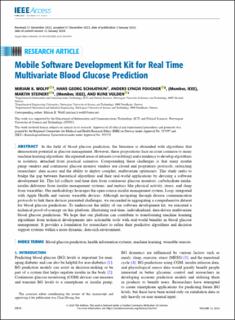| dc.contributor.author | Wolff, Miriam Kopperstad | |
| dc.contributor.author | Schaathun, Hans Georg | |
| dc.contributor.author | Fougner, Anders Lyngvi | |
| dc.contributor.author | Steinert, Martin | |
| dc.contributor.author | Volden, Rune | |
| dc.date.accessioned | 2024-03-14T10:33:19Z | |
| dc.date.available | 2024-03-14T10:33:19Z | |
| dc.date.created | 2024-01-02T09:53:58Z | |
| dc.date.issued | 2024 | |
| dc.identifier.citation | IEEE Access. 2024, 12 5910-5919. | en_US |
| dc.identifier.issn | 2169-3536 | |
| dc.identifier.uri | https://hdl.handle.net/11250/3122380 | |
| dc.description.abstract | In the field of blood glucose prediction, the literature is abounded with algorithms that demonstrate potential in glucose management. However, these propositions face an issue common to many machine learning algorithms: the repeated reuse of datasets (overfitting) and a tendency to develop algorithms in isolation, detached from practical scenarios. Compounding these challenges is that many insulin pump vendors and continuous glucose monitor vendors use closed and proprietary protocols, restricting researchers’ data access and the ability to deploy complex, multivariate optimizers. This study seeks to bridge the gap between theoretical algorithms and their real-world applications by devising a software development kit. This kit collects real-time data from continuous glucose monitors, carbohydrate intake, insulin deliveries from insulin management systems, and metrics like physical activity, stress, and sleep from wearables. Our methodology leverages the open-source insulin management system, Loop, integrated with Apple Health and various wearable devices. Although navigating through diverse communication protocols to link these devices presented challenges, we succeeded in aggregating a comprehensive dataset for blood glucose predictions. To underscore the utility of our software development kit, we executed a technical proof-of-concept on this platform, illustrating real-time, individualized, data-driven multivariate blood glucose predictions. We hope that our platform can contribute to transforming machine learning algorithms from technical developments into actionable tools with real-world benefits in blood glucose management. It provides a foundation for researchers to refine their predictive algorithms and decision support systems within a more dynamic, data-rich environment. | en_US |
| dc.language.iso | eng | en_US |
| dc.publisher | IEEE (Institute of Electrical and Electronics Engineers) | en_US |
| dc.relation.uri | https://ieeexplore.ieee.org/document/10379644/ | |
| dc.rights | Navngivelse 4.0 Internasjonal | * |
| dc.rights.uri | http://creativecommons.org/licenses/by/4.0/deed.no | * |
| dc.subject | Blodsukkerregulering | en_US |
| dc.subject | Blood glucose regulation | en_US |
| dc.subject | Prediksjon av glukosenivå | en_US |
| dc.subject | Glucose level prediction | en_US |
| dc.subject | Diabetes | en_US |
| dc.subject | Diabetes | en_US |
| dc.title | Mobile Software Development Kit for Real Time Multivariate Blood Glucose Prediction | en_US |
| dc.title.alternative | Mobile Software Development Kit for Real Time Multivariate Blood Glucose Prediction | en_US |
| dc.type | Journal article | en_US |
| dc.type | Peer reviewed | en_US |
| dc.description.version | publishedVersion | en_US |
| dc.subject.nsi | VDP::Medisinsk teknologi: 620 | en_US |
| dc.subject.nsi | VDP::Medical technology: 620 | en_US |
| dc.source.pagenumber | 5910-5919 | en_US |
| dc.source.volume | 12 | en_US |
| dc.source.journal | IEEE Access | en_US |
| dc.identifier.doi | 10.1109/ACCESS.2024.3349496 | |
| dc.identifier.cristin | 2218641 | |
| cristin.ispublished | true | |
| cristin.fulltext | original | |
| cristin.qualitycode | 1 | |

